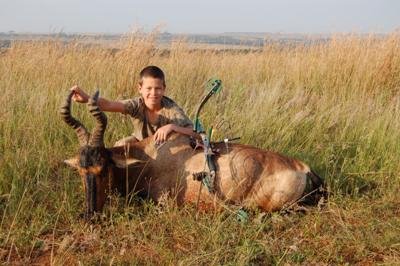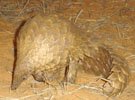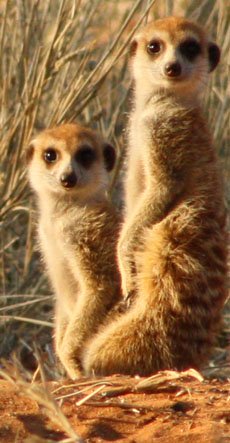Preparing a young hunter for success.
by Laurent Adamson
(Pretoria, Gauteng, South Africa)
He didn't give me any choice but to meet him the next day at a bow shop. I bought my first bow that day, together with all the bells and whistles – arrows, carry case, release (trigger), range finder – the whole deal. I even bought broadheads.
The following few days I couldn't do anything but shoot my new bow and tune the sights in. It was five days after I bought my bow that Jaco called me and said, "I am picking you up tomorrow morning at four, be ready – we are going hunting". And so the following morning, after a 90-minute drive to a hunting farm near Derby, at about 6am, I found myself sitting alone in a hide, freezing to death.
The warmth left my body faster than a chocolate milkshake sucked up by a fat kid.
At 9:15am, while I embraced the rays of sunlight shining through the shooting hole in front of me, a herd of Blue Wildebeest entered the feeding area. Despite the immediate adrenalin rush I felt, I was surprised at how collected I really was. I took my bow carefully from the hook, attached my release to the loop of the string - the arrow already nocked - and started looking for the biggest kill. I spotted a huge cow standing broad side at a salt lick I earlier ranged at 20 yards. I drew my bow and took aim at the shoulder where my "little book" indicates the right shot placement. I released the arrow, which to my disappointment, penetrated the animal at least four inches to the back from where I aimed.
The tone in my voice must have revealed the mixed feelings inside me when I called the field personnel over the radio. They arrived twenty minutes later, which felt like an eternity as the anxiety of losing the Blue Wildebeest started to get the better of me. I took the blood trail at a pace that left the trackers nagging me to slow down. I told them, "I am not losing this animal today". After tracking the Blue Wildebeest for about four kilometers, in a narrow animal path, the drops of blood finally disappeared. I told one of the trackers, who by now was gasping for breath, that he should search around for blood while I go and check ahead. I followed the trail around a bend for another thirty metres when I heard a snort. On my right, the Blue Wildebeest was lying under a tree.
Thick shrub prevented me from taking another shot, so I stalked around to its right side. I was about twenty metres from it when the noise of a twig breaking made it jump to its feet. I froze. Some low hanging shoots from a bush between us obscured my view, making a clean shot impossible. I slowly went on one knee from where, underneath the branches, I could just see enough of the front quarter of the animal to take a shot. As I cautiously drew my bow, I could swear the pounding in my chest was almost audible. I aimed... aimed and released. Before I could decide whether the shot was good or not, the Blue Wildebeest moved two strides forward and collapsed to the ground. This time, the arrow went through the centre of its heart, killing it instantly.
I afterwards realized how easily this first-time, head-over-heals bow hunting excursion could have gone completely wrong. If the outcome was different, I might have lost all my enthusiasm and appetite for bow hunting that day. But good fortune was on my side. I was instantly hooked on bow hunting and decided to get my whole family involved. That following week I bought my son and daughter each a bow.
My son, nine years old at the time and as adventurous as a boy of his age can be, also wanted to go hunting immediately after getting his bow. However, with that first bow hunting day vividly engraved in my memory, I promised myself to prepare him well for his first ever hunting experience, not to spoil the most exiting day of his life.
We agreed on a goal; the day he is able to pull his bow at 45 pounds, and be able to consistently shoot a tight grouping at 20 yards, he can go hunting. We immediately started to exercise together on a regular basis. He was only able to pull his bow at 35 pounds and, although he did not shoot bad, he could not manage the greatest of groupings with five arrows. I started to read as much as possible about archery and hung out at bow shops to pick up as much information as I could.
We both learned a lot... fast. He quickly gained strength and every few weeks we increased the poundage on his bow with only two or three pounds. Every time we had to adjust the sights slightly to keep the arrows on the target. As the months passed he started managing the more important shooting techniques, such as anchor point, grip and stance. By the end of that same year he managed to pull his bow at 45 pounds while shooting much more consistently. Needless to say, he did not go hunting that season during which his patience worn thin, especially after I had the joy of harvesting two warthogs and three impalas.
I soon realized that shooting consistently well, will not be the only requirement to equip him for the hunt. Simply by sitting with his Dad in the hide, see him release the arrow and be there when the animal gets slaughtered, is not going to prepare him for that crunch moment. Being emotionally prepared for such a young, first-time hunter, is crucially important. What about "bok koors" (buck fever)?
I quickly found a solution to my new challenge. He already new all the shot placements for the different species by studying them from our "little book" while sitting in the hides with me. So, we started practicing at a 3D shooting range just outside Pretoria with over fifteen different "species". We practiced there often at different distances. His target practice paid off; he managed to hit the kill zones every time. Early last year, he was able to pull his bow at 50 pounds and consistently shoot a tight grouping at 20 yards. In my book it was pretty impressive for a ten year old boy.
All that remained now was to set up his bow for the hunt. His draw length was 23 inches, his arrows weighed 370 grain (including a 100gn Nitron broadhead) and flew at 200fps. With the Nitron broadheads on his arrows, we tested the flight of his arrows by shooting at a broadhead butt, which turned out to be perfect. We both was satisfied that he was as ready as can be for the most memorable day of his life. IT WAS TIME!
The big day has finally arrived. His excitement was almost tangible very early that morning of the 7th of April 2009, when we left for his first hunt. Unpacking the vehicle was never done that quick, even though it was still dark. We got our bows and arrows (his fixed with broadheads this time) and quickly shot the required test shot into the butt – he had hit the black dot in the centre.
On the back of the field vehicle on our way to the hide, which he picked, it was dead quiet. We never discussed what species he was going to hunt. I guess that was of less importance to him and I also could not care as long as he gets his kill. Once in the hide, his apparent confidence surprised me. He immediately arranged his bow and arrows for action and, with his bow in hand, imitated his draw through the shooting hole from different angles. He familiarized himself with the feeding area in front of the hide by ranging the distances of a few identified spots – exactly as he saw me doing before. He took position in his chair and calmly smiled at me.
He took one step back and said, "Pappa, perfect shot".
Around 7:00am we spotted a Red Hartebeest approaching. At 7:15am the Red Hartebeest was standing broad side, 16 yards in front of us, feeding on lucern. My video camera was already rolling to capture this moment of a lifetime – my son's first hunt. He stood alongside me with his bow in his hand, arrow nocked. He looked at me with a facial expression that pleaded for the "go-ahead". I single nod of my head was all he needed.
He slowly raised his bow, quietly took the draw and aimed. I wanted to whisper in his ear where to place the spot when, to my surprise, he released the arrow. The animal jetted away down to the grass land. My son took one step back and said, "Pappa, perfect shot".
It took me a few seconds to locate the Red Hartebeest through the lens of the camera. It was now walking in the long grass about eighty yards from us. As I watched it walk without any sign of being shot, I started to fear the worst. I asked, "Son, you say it was a perfect shot?" At the moment I said "shot", we both saw the Red Hartebeest go down and, as if someone gave us the count to three, we simultaneously started cheering.
The “perfect shot” turned out to be the shot that all bow hunters yearn for. The arrow went through the top of the heart and pierced both lungs.
I congratulated my son with his first kill and still cherish those proud moments I was privileged to share with him. I'm sure it is every bow-hunting father's aspiration to see his son at a young age hunting his first animal.
However, I trust that every such father, having read this article, will realise that preparing your son (or daughter) for one of the greatest moments you will share together, will be worth the patience, the effort and the wait.
Laurent Adamson
Comments for Preparing a young hunter for success.
|
||
|
||

Meaning of "Uitspan"
'Uitspan' is an Afrikaans word that means place of rest.
When the Boer settlers moved inland in Southern Africa in the 1800's, they used ox carts. When they found a spot with game, water and green grass, they arranged their ox carts into a circular laager for protection against wild animals and stopped for a rest.
They referred to such an action of relaxation for man and beast, as Uitspan.
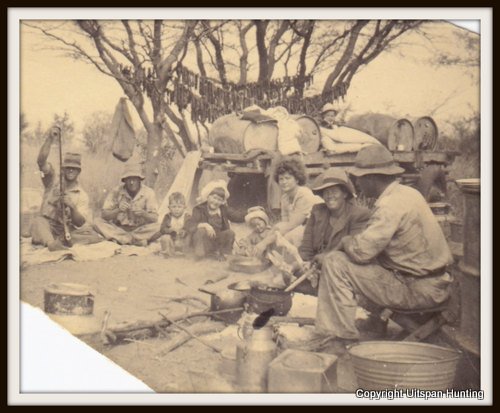
(Picture above of our ancestors.)
Did you know?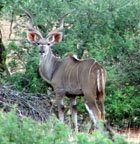 Greater Southern Kudus are famous for their ability to jump high fences. A 2 m (6.56 ft) fence is easily jumped while a 3 m (9.84 ft) high fence is jumped spontaneously. These strong jumpers are known to jump up to 3.5 m (11.48 ft) under stress. |
to read about my experience...
Did you know? Some animals have one sense more than man!The flehmen response is a particular type of curling of the upper lip in ungulates, felids and many other mammals. This action facilitates the transfer of pheromones and other scents into the vomeronasal organ, also called the Jacobson's Organ. Some animals have one sense more than man!The flehmen response is a particular type of curling of the upper lip in ungulates, felids and many other mammals. This action facilitates the transfer of pheromones and other scents into the vomeronasal organ, also called the Jacobson's Organ.This behavior allows animals to detect scents (for example from urine) of other members of their species or clues to the presence of prey. Flehming allows the animals to determine several factors, including the presence or absence of estrus, the physiological state of the animal, and how long ago the animal passed by. This particular response is recognizable in males when smelling the urine of a females in heat. |
